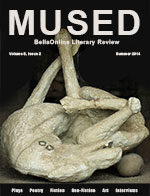Rachel Thompson - In Her Own Words
Rachel Thompson
Everyone has a story to tell. However, most people donít think about writing them down and it wasnít until a friend asked me to contribute to an anthology that I thought seriously about writing nonfiction. Once I had written that first memoir, I wanted to work at improving my writing and began taking classes at a local writerís center. I also joined an informal writing group that meets twice a month. Itís a small, supportive group that uses prompts from books such as Judy Reevesí
A Writerís Book of Days as inspiration. Typical prompts are ones like these:
"write about getting up in the morning" and
"write about stolen moments." After writing for ten minutes, we share by reading aloud what we have written and also bring copies of our longer pieces for the group to critique. This is invaluable because it provides us with a safe environment where others offer constructive criticism as well as suggestions and encouragement on how to improve our work.
An example of how a short piece of writing turned into a longer memoir was when the prompt
"The Mary Tyler Moore Show" got me thinking about a time in my twenties when I would regularly go home after work and watch reruns of the show to unwind. I ended up developing this into a much longer "coming of age" story which explained how, over the course of a year, I dealt with a particularly difficult time in my life.
They are other times when I find prompts arenít necessary, such as when something happens to me and I see right away it has the makings of a story. After breaking a bone in my foot last year, I knew that once everything had healed, this would be a story I would need to retell. The piece, which I called "Lucky," described the experience but, instead of focusing on the accident itself or even much of the healing process, I wrote about feeling appreciation and gratitude for what I had lost and regained.
My first step in the writing process is to write in longhand in my journal. This way I let the ideas flow from my head to pen and paper; I try to keep writing and not look back at what Iíve just written. The next step is to type this on my computer and only then do I begin editing. I read, reread, add, delete, move things around and also read it aloud. After that, I need some space and time before coming back to it. I often think about the piece as I am doing other things and if a phrase or idea comes to mind, I jot it down. When I think I might finally be ready to get some feedback, itís at this point that I will share the story with others.
Some things donít come together quickly and they need to sit, filed away, only to be resurrected at a later date. I once wrote a story about travelling to the Philippines that, despite some good elements, didnít quite work as a completed piece. When I presented it to my writing group two years later, I was able to come up with a satisfying conclusion and sent it off to a South East Asian publication which quickly accepted it for their online magazine.
Writers need to readóand the more different types of things you read, the better. Although I write primarily nonfiction, I find that whatever I read teaches me about writing and also inspires me. I wrote "Survivor" after reading a memoir set in the U.S. during World War II which gave me the idea to talk to my mother-in-law and write down her story from that same time period.
Writing nonfiction jogs my memory, allowing me to relive moments and even helps make sense of the past. Itís a challenge to create something and satisfying to see a story take shape, ending up in a form that others can read and appreciate.

